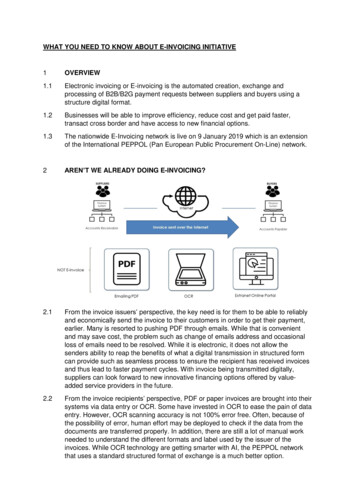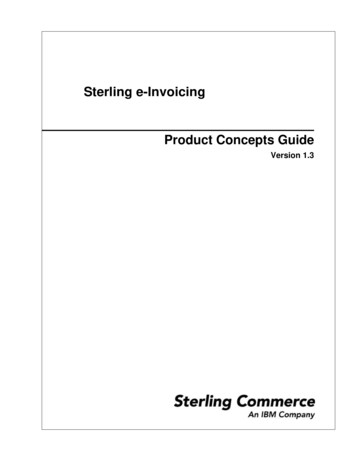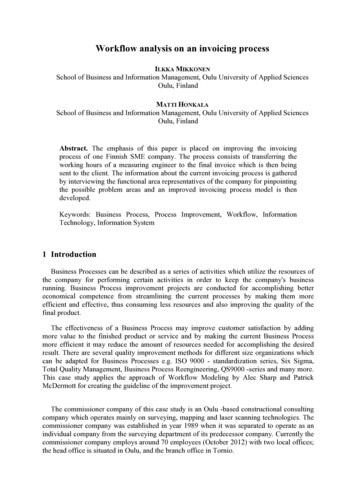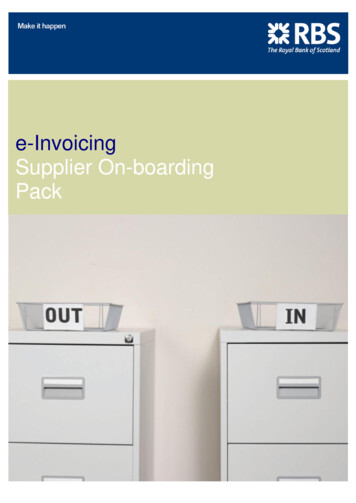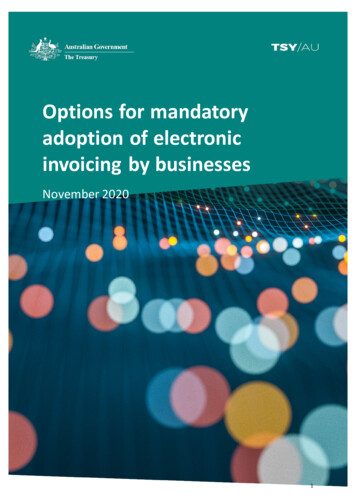
Transcription
Options for mandatoryadoption of electronicinvoicing by businessesNovember 20201
Commonwealth of Australia 2020This publication is available for your use under a Creative Commons Attribution 3.0 Australia licence,with the exception of the Commonwealth Coat of Arms, the Treasury logo, photographs, images,signatures and where otherwise stated. The full licence terms are available legalcode.Use of Treasury material under a Creative Commons Attribution 3.0 Australia licence requires you toattribute the work (but not in any way that suggests that the Treasury endorses you or your use ofthe work).Treasury material used ‘as supplied’.Provided you have not modified or transformed Treasury material in any way including, for example,by changing the Treasury text; calculating percentage changes; graphing or charting data; or derivingnew statistics from published Treasury statistics — then Treasury prefers the following attribution:Source: The Australian Government the Treasury.Derivative materialIf you have modified or transformed Treasury material, or derived new material from those of theTreasury in any way, then Treasury prefers the following attribution:Based on The Australian Government the Treasury data.Use of the Coat of ArmsThe terms under which the Coat of Arms can be used are set out on the Department of thePrime Minister and Cabinet website (see ther usesEnquiries regarding this licence and any other use of this document are welcome at:ManagerMedia and Speeches UnitThe TreasuryLangton CrescentParkes ACT 2600Email: media@treasury.gov.au2
ContentsContents . .3Consultation Process .4Request for feedback and comments .4Publication of submissions and confidentiality .4Further consultation process .4Closing date for submissions: 18 January 2021 .4Introduction .5About e-Invoicing .6What is e-Invoicing? .6Benefits of e-Invoicing .6Efficient .6Faster payments .6Secure and accurate .6Compatible .7Enables data-driven decision-making.7Environmentally friendly.7How does Peppol e-Invoicing work? .7Graph 1: Peppol e-Invoices are transmitted through the Peppol network .7Graph 2: The 4-corner model of Peppol e-Invoicing .8The Australian Peppol Authority .8Budget 2020-21 .9How can businesses adopt Peppol e-Invoicing? .9For small and medium businesses . 10For medium and large businesses. 10E-Invoicing adoption. 11Factors affecting adoption . 11Options to accelerate adoption of e-Invoicing . 11Option 1: Phased in requirement for all businesses . 12Option 2: Require only large businesses to adopt e-Invoicing . 14Option 3: Non-regulatory actions . 14Consultation questions — Peppol e-Invoicing adoption . 16E-Invoicing and payment times . 17Long and late payment times . 17Government action in relation to payment times . 17Supplier Pay On-Time or Pay Interest Policy . 18Payment Times Reporting Scheme . 18State and Territory Governments . 18Other Action — Industry Code . 18Consultation questions — e-Invoicing and payment times . 193
Consultation ProcessRequest for feedback and commentsInterested parties are invited to comment on the issues raised in this paper by 18 January 2021.While submissions may be lodged electronically or by post, electronic lodgement is preferred. Foraccessibility reasons, please submit responses sent via email in a Word or RTF format. An additionalPDF version may also be submitted.Publication of submissions and confidentialityAll information (including name and address details) contained in formal submissions will be madeavailable to the public on the Australian Treasury website, unless you indicate that you would like allor part of your submission to remain confidential. Automatically generated confidentialitystatements in emails do not suffice for this purpose. Respondents who would like part of theirsubmission to remain confidential should provide this information marked as such in a separateattachment.Legal requirements, such as those imposed by the Freedom of Information Act 1982, may affect theconfidentiality of your submission.Further consultation processThe Treasury will also consult broadly with industry representatives and other interested parties onthe topics discussed in this consultation paper. This may involve conducting targeted consultationwith these stakeholders on specific issues where more information and views are required.Closing date for submissions: 18 January 2021ContactMatthew SedgwickEmaile-Invoicing@treasury.gov.auMailData Economy UnitThe TreasuryLangton CrescentPARKES ACT 2600EnquiriesEnquiries can be directed to e-Invoicing@treasury.gov.auMedia enquiries should be directed to medialiaison@treasury.gov.au or 61 2 6263 2300The principles outlined in this paper have not received Government approval and are not yet law.Therefore, this paper is merely a guide as to how the principles might operate.4
IntroductionThe Government recognises the important role of digital technologies in driving productivity growthand supporting Australia’s recovery from the impacts of COVID-19. Digital capabilities can increasethe resilience of businesses and create new opportunities for growth.Electronic invoicing (e-Invoicing) allows the digital exchange of invoices between a supplier’s and abuyer’s software or systems using a secure network and a common proven standard.Deloitte Access Economics 1 estimates that every time an e-Invoice replaces a paper invoice, it candeliver up to 20 in cost savings to the businesses involved. With over 1.2 billion invoices beingexchanged in Australia annually, and 89 per cent of small and medium enterprises (SMEs) stillprocessing paper-based invoices 2, e-Invoicing can deliver significant benefits to Australian businessesand the wider Australian economy. The adoption of e-Invoicing will determine the degree to whichbenefits are realised.In 2019, Australia adopted the Pan-European Public Procurement OnLine (Peppol) framework.Peppol is an internationally recognised framework for e-Invoicing and e-Procurement, used by over30 countries in Europe, Asia and North America. While there has been interest in the potentialbenefits of Peppol e-Invoicing in Australia, voluntary adoption has been modest in both the publicand private sectors.As adoption of Peppol e-Invoicing reaches higher levels, significant network benefits will be unlockedfor its users, prompting consideration of ways to accelerate its adoption.As part of Budget 2020-21, the Government announced that it will seek to accelerate the adoption ofPeppol e-Invoicing, starting with the public sector. The Government will mandate that allCommonwealth Government agencies must be able to receive Peppol e-Invoices by 1 July 2022. TheGovernment will also work with the States and Territories on how state and local governments canalso accelerate e-Invoicing adoption.Greater adoption in the public sector can be beneficial for its agencies and their supply chains, notingthat the public sector accounts for under 10 per cent of business invoices in Australia 3. Governmentadoption can also lead to more widespread adoption across the economy, although internationalevidence suggests that widespread adoption may occur more slowly than is desirable.This paper seeks to consult on further actions that the Government can take to accelerate theadoption of Peppol e-Invoicing in the private sector, including options for mandatory adoption bybusinesses. Such a mandate could be effective at increasing adoption by businesses but it could alsoimpose a significant regulatory burden on some businesses. Moreover, as e-Invoicing can deliverenhanced invoice processing efficiency and accuracy, this paper also seeks to consult on how aPeppol e-Invoicing mandate for businesses can reduce payment times from large to small businesses.Deloitte Access Economics 2016, “The Economic Impact of E-invoicing”Deloitte Access Economics 2016, “The Economic Impact of E-invoicing”3Deloitte Access Economics 2016, “The Economic Impact of E-invoicing”125
About e-InvoicingWhat is e-Invoicing?E-Invoicing allows the digital exchange of invoices between a supplier’s and a buyer’s software orsystems. E-Invoices are exchanged using a secure network and a common proven standard such asPeppol, which allow different software or systems to communicate with each other, similar to beingable to make a phone call to another phone, regardless of either phone’s model, brand or carrier.Benefits of e-Invoicinge-Invoicing can deliver a range of benefits for Australian businesses.EfficientTraditional invoicing processes can be time-consuming. For suppliers, these processes can involveprinting, storing, posting or emailing invoices. Upon receipt of the invoice, the buyers may have tomanually sort, scan and re-key the invoice information into their software or systems.E-Invoices are sent between the supplier’s and the buyer’s software or systems, without the need forprinting, re-keying, posting or emailing of invoices. This reduces processing time and costs for boththe suppliers and the buyers. With Peppol, software and service providers can build electronicvalidation to further reduce human errors and automate processing to create more efficiencies.Faster paymentsThe time savings from e-Invoicing can lead to faster payments to suppliers. Moreover, e-Invoicingreduces the occurrence of human errors associated with traditional invoicing such as lost invoicesand incorrect addresses, which cause payment delay 4.The greater speed of e-Invoicing has helped the Commonwealth Government implement its currentfive-day payment policy, which is helping to boost the cash flow of its small business suppliers whoparticipate in e-Invoicing. The Commonwealth Government is also working with the States andTerritory Governments for states and local governments to improve their payment time policies.Secure and accurateE-Invoices are exchanged more securely than email, reducing the risk of email scams andransomware attacks.The Peppol network also has an in-built database of addresses for the accurate delivery of invoices tocorrect buyers.Billentis 2015, “Implementing E-Invoicing on a Broad Scale menting e-invoicing on a broad scale in australia.pdf?acsf files redirect46
CompatibleE-Invoicing utilises a common, proven, open standard that can allow businesses to use their ownsoftware or systems to interact with their trade groups more easily.Some larger businesses have their own electronic data interchange (EDI) networks 5 enabling them togain the benefits of electronic transmissions of invoices. However, these EDI networks are ‘islands oftrade’, meaning they are closed to businesses outside the trade groups. These EDI networks alsomake it more complex for businesses who deal with multiple trade groups, as these businesses haveto manage multiple networks, each with different requirements.Peppol e-Invoicing allows small businesses to use their own software or system to send and receivee-Invoices with their trade partners regardless of the systems they use.Peppol e-Invoicing can also be used together with existing EDI systems, so large businesses usuallywould not need to replace these systems.Enables data-driven decision-makingThe digitisation of invoicing data will deliver faster, more accurate and complete data, supportingreal-time business decisions for cash flow, procurement, and stock management.Environmentally friendlyE-Invoicing eliminates paper, uses less energy and resources, and minimises physical storage space,which are all important sustainability focuses for many Australian businesses and their customers.How does Peppol e-Invoicing work?The Peppol framework utilises a 4-corner model, similar to Australia’s SuperStream 6 frameworkimplemented in 2015. Below are diagrams of how e-Invoices are exchanged in the Peppol networkusing this model.A supplier would first enter the invoice information into their software or system and send theinvoice. The invoice will be transmitted in the Peppol network and be recorded in the buyer’ssoftware or system for action.Graph 1: Peppol e-Invoices are transmitted through the Peppol networkRECEIVEINVOICECREATEINVOICESUPPLIERPEPPOL E-INVOICING NETWORKBUYERAn EDI system (electronic data interchange) is a point-to-point solution, allowing the electronic exchange ofinvoices and other data within a certain trade group. These systems are commonly referred to as “islands oftrade” or “closed trading networks” due to their proprietary nature. These systems are often a highly tailoredand specific software, portal, or a web login interface, which make them attractive to users inside the tradegroup but very inconvenient for outside users.6SuperStream is the way businesses must pay employee superannuation guarantee contributions to superfunds. SuperStream allows money and information to be transmitted electronically and consistently across thesuper system — between employers, funds, service providers and the ATO.57
By using the Peppol framework for e-Invoicing, Australian businesses can take advantage of Peppol’sglobal network, allowing them to send e-Invoices to members of the network around the world tosupport global trading opportunities.Graph 2: The 4-corner model of Peppol e-Invoicing 7Corner 1Corner 4PreparationProcessedThe buyer receives theinvoice in theirsoftware or system.The supplier enters theinvoice in their softwareor system.Address lookupRetrieve delivery addressAccess points use the buyer’s ABNto retrieve the right destinationdetails for the buyer from thePeppol Service Metadata Locator(SML) and Service MetadataPublishers (SMPs).Corner 2Sent via Peppol networkCorner 3Access point sendsinvoiceMore secureAccess point receivesinvoiceThe supplier’s Peppolcertified access pointsends the invoice.The invoice is sent overthe Peppol networkThe buyer’s Peppolcertified access pointreceives the invoice.The Australian Peppol AuthorityIn December 2019, Australia adopted Peppol e-Invoicing after legislation established the AustralianTaxation Office (ATO) as the Australian Peppol Authority, which is responsible for developing andadministering the e-Invoicing framework in Australia.The Peppol Authority has been focused on increasing the adoption of e-Invoicing by engaging with arange of government bodies and businesses. It has also been engaging with an increasing number ofsoftware and service providers to encourage the development of e-Invoicing solutions for theirclients.7More information on Peppol is available at www.peppol.eu/what-is-peppol/8
The Peppol Authority has also tailored the Peppol standards to support Australian requirements (e.g.tax invoice) and set the appropriate security requirements for local service providers. It has alsoaccredited over 20 local service providers who are now trusted to provide essential e-Invoicingservices in the Peppol network, such as service metadata publisher and access points. Moreinformation, including the current list of accredited service providers, is available -invoicing-accredited-service-provider/.The ATO (the Peppol Authority) and other Australian government agencies do not have access to thee-Invoices exchanged between businesses, meaning they cannot view the e-Invoices’ contents anddetails.Budget 2020-21In the recent Budget 2020-21, the Government announced its intention to accelerate e-Invoicingadoption. Amongst other actions, the Government has provided funding until June 2022 for the ATOin its role as the Peppol Authority, to continue working with all levels of government, with the aim ofencouraging adoption and assisting with implementation of Peppol e-Invoicing. This includes: Actively promoting awareness of e-Invoicing to encourage early adoption amongst governmentbodies. Engaging with service providers of government bodies to encourage development offit-for-purpose e-Invoicing solutions. Providing direct support to government bodies who need assistance or guidance for e-Invoicingadoption. Providing a suite of information resources and tools to support e-Invoicing adoption bygovernment bodies. Establishing a Whole-of-Government Panel to support procurement of e-Invoicing access pointand reduce integration costs for government bodies.How can businesses adopt Peppol e-Invoicing?There are a variety of ways that businesses can adopt Peppol e-Invoicing. Below are a few commonscenarios that illustrate how different businesses can do this. Businesses are encouraged to seekguidance on how best to adopt e-Invoicing. 88More information is available at www.ato.gov.au/business/e-invoicing/9
For small and medium businessesSimon, a small business owner finds out that his trading partners are already using Peppole-Invoicing and decides to adopt it for his business.Scenario 1:Simon wants to continue using his online accounting software package.His accounting software provider advises that the software will be updated for Peppol e-Invoicingby mid-2021. This may come at no cost to his existing subscription. He will be able to use hissoftware to send and receive Peppol e-Invoices.Scenario 2:Simon wants to continue using his desktop (on-premises) accounting software that is specific tohis industry.He can still use his existing software for Peppol e-Invoicing by procuring the services of a Peppolaccess point from an accredited service provider. This will allow him to use his software to sendand receive Peppol e-Invoices.Scenario 3:Simon normally invoices manually and wants to start using an e-Invoicing software.He could subscribe to software already enabled for Peppol e-InvoicingAlternatively, he could use an online portal offered by a service provider to send and receivePeppol e-Invoices. These options are available at low to no cost.For medium and large businessesJenny, the finance director of a large business wants to use e-Invoicing to reduce costs andinefficiencies associated with manual processing. She learns that her trading partners are alreadyusing Peppol e-Invoicing, which enable them to exchange e-Invoices with any other businesses inthe Peppol network using their software.Scenario 1:Jenny’s business uses an electronic data interchange (EDI) system, which allows her toelectronically exchange data, including invoices, within her trade groups.She does not have to replace her existing EDI system as Peppol e-Invoicing can be used togetherwith her current system. A Peppol e-Invoicing service provider, or her existing EDI provider, canassist with this integration.Scenario 2:Jenny’s business uses an enterprise resource planning (ERP) system, which allows her toconsolidate and manage key business processes such as accounting, procurement and supplychain operations.She does not have to replace her ERP system because it can be enabled for Peppol e-Invoicing. APeppol e-Invoicing service provider, or her existing ERP provider, can assist with this integration.10
E-Invoicing adoptionFactors affecting adoptionThere are a number of key factors that determine whether and how a business chooses to adopte-Invoicing9: Business size: Large businesses are more likely to adopt e-Invoicing than small businesses becausethey tend to process higher volumes of invoices. Business activities: Purchasing businesses are more likely to adopt e-Invoicing than suppliersbecause they tend to process higher volumes of invoices. Existing systems: Businesses with IT systems that can support digital technologies are more likelyto adopt e-Invoicing. However, businesses that already have EDI systems may view e-Invoicing asduplicative. Adoption costs: Cost of Peppol e-Invoicing solutions will depend on the business, but can rangefrom low (e.g. included in current software subscription) to more expensive (e.g. procuring Peppolaccess point and integration services). The cost also depends on the readiness of software andservice providers to support Peppol e-Invoicing. Network effects: E-Invoicing is considered a ‘network good’, wherein the number of users in thenetwork will influence the degree to which many of its potential benefits can be realised. Themore users there are in the network, the more benefits users will gain, and the more likelybusinesses will adopt e-Invoicing.Recently, a number of major accounting software providers for SMEs have indicated that they will beable to support Peppol e-Invoicing by mid-2021 10. Hence, it is expected that over 60 per cent 11 ofSMEs will be able to use Peppol e-Invoicing through their existing accounting software by that time.Network effects are significant in that one business’s decision to adopt e-Invoicing can directlyimpact other businesses’ adoption decisions. Currently, as there are only a small number ofbusinesses that utilise Peppol e-Invoicing in Australia, other businesses have less incentive to adoptbecause they can only exchange Peppol e-Invoices with a small number of users.The reliance on network effects to realise significant benefits means that it may not be a priority for abusiness to adopt Peppol e-Invoicing without knowing if others will also adopt.International experience 12 suggests that even with a mandate for the public sector, which accountsfor less than 10 per cent of business invoices in Australia, it could still take many years for Peppole-Invoicing to be widely adopted across the economy.Options to accelerate adoption of e-InvoicingThe Government seeks to understand the impacts that different options for accelerating Peppole-Invoicing adoption can have on businesses and the wider economy.Deloitte Access Economics 2016, “Economic impact of e-Invoicing”In May 2020, Xero announced that its users could send e-invoices for no extra cost to their existingsubscriptions.11Internal ATO figure12Billentis 2019, “The e-invoicing journey 2019-2025”,www.billentis.com/The einvoicing journey 2019-2025.pdf91011
The Government is considering the following options for accelerating the adoption of Peppole-Invoicing in the private sector: Option 1: a phased approach to introducing a requirement that all businesses adopt Peppole-Invoicing (without prohibiting paper invoices); Option 2: a mandate for large businesses only; and Option 3: non-regulatory options to such as a voluntary code of e-Invoicing and/or promotion ofPeppol e-Invoicing by enabled organisations.Note that any mandate would not prohibit businesses from continuing to send and receivenon-Peppol invoices such as paper and PDF invoices.Option 1: Phased in requirement for all businessesThis option involves a phased approach to requiring all businesses to have the capability to send andreceive Peppol e-Invoices, starting with large businesses. Key reasons for this approach include: It allows smaller businesses more time to plan their adoption. It allows software and service providers more time to develop effective and affordable solutionsfor a greater variety of clients. It allows smaller businesses to adopt e-Invoicing when there are more users to exchangee-Invoices.Potential advantages This option accelerates e-Invoicing adoption and brings forward the wide range of significantbenefits associated with higher rates adoption. This option could boost the number of software providers offering e-Invoicing services to themarket, especially if software providers are given the time to develop products prior to a mandatecoming into effect. Enhanced competition among software providers could lead to moreaffordable and effective products for business clients. This option can ensure that e-Invoicing becomes part of the broader digitisation of businesses,promoting digital innovation, creating new opportunities and building business resilience.Potential disadvantages A mandate could impose significant regulatory costs on businesses. Some businesses that processlow volumes of invoices and don’t use business software or systems may find adopting e-Invoicingto be more challenging and/or expensive. Some businesses may not have the funds to invest ine-Invoicing even when there is a positive return over time, noting that:– The cost of e-Invoicing adoption will depend on the business and the provided services.– Many businesses will need to invest time and resources to understand e-Invoicing and changesto their software or systems.– These adoption costs are generally already deductible under the tax system. Mandating e-Invoicing for businesses at this point in time may limit the number of softwareproviders to only those that can be ready quickly.Phasing in by focusing on large businesses firstThere are a number of potential ways to define large businesses that could be covered by therequirement to use e-Invoicing, including using:12
The same threshold as is set out in the Payment Times Reporting Act 2020 ( 100 millionturnover) 13. This will capture around 3,400 14 businesses in Australia. The definition of a large/medium taxpayer for the tax agent lodgement program ( 10 millionturnover) 15. This will capture around 30,000 16 businesses in Australia. Other existing definitions. A new definition.Legislation of the mandateThe Constitution limits the Commonwealth’s powers in relation to the regulation of businesses. Assuch, a mandate could be legislated via amendments to existing corporation legislation. This maymean unincorporated businesses such as sole traders may not be subject to a mandate forbusinesses.Time required to comply with the mandateA number of the major small business accounting software providers have indicated they will beready to support e-Invoicing by mid-2021. Over time, it is also expected that there will be more freeor low-cost options available in the market.A number of EDI or ERP system providers have indicated that they would need approximately 3 to 6months to become e-Invoicing enabled. However, some may need longer to make technology andprocess changes for Peppol e-Invoicing.It is important to ensure that a suitable amount of time is provided for businesses to comply with amandate, by announcing it and having it coming to effect later. This would help achieve a widerrange of e-invoicing products coming to market, fostering competition, and keeping downwardpressure on costs for business. A mandate that forces businesses t
The time savings from e-Invoicing can lead to faster payments to suppliers. Moreover, e-Invoicing reduces the occurrence of human errors associated with traditional invoicing such as lost invoices and incorrect addresses, which cause payment delay. 4. The greater speed of e-Invoicing has helped the CommonwealthGovernment implement its current
